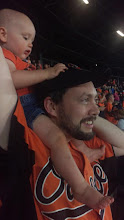In the storied career of Jim Palmer, the dates of May 16 and 17 represent beginnings and endings.
On Sunday afternoon, May 16, 1965, the Orioles hosted the Yankees at Memorial Stadium. A Curt Blefary homer off of New York starter Jim Bouton staked Dave McNally to a 1-0 lead, but the O's lefty was chased from the game in just the third inning after allowing five straight hitters to reach base with one out. With Mickey Mantle on first base following a two-run single, a 19-year-old Jim Palmer was called in from the bullpen to make his seventh career big league appearance and hopefully to stop the bleeding at 4-1. He did just that, inducing a double-play grounder from Hector Lopez to end the inning. Meanwhile, "Bulldog" Bouton gave up a couple more home runs, and with them, the lead. First baseman Norm Siebern took him deep with the bases empty in the bottom of the third, and an inning later Palmer himself delivered the equalizer, a two-run shot for his first major league home run. Jim blanked the Yanks in innings four and five, but dug himself a hole with a pair of walks and a Tony Kubek RBI single in the sixth, putting New York on top 5-4. Palmer was removed for pinch hitter Russ Snyder in the bottom of the sixth; Snyder struck out against reliever Pete Mikkelsen, but Paul Blair walked ahead of a Luis Aparicio two-run homer to put Baltimore's rookie pitcher in line for the win. A Blefary run-scoring double provided an eighth-inning insurance tally, and Don Larsen and Stu Miller kept the Bronx Bombers from crossing the plate in the late frames. On the same day, Jim Palmer had his first career home run (of three) and his first career win (of 268).
A less auspicious day in mid-May - May 17 - reared its ugly head 19 years later. It was early in the 1984 season, and the defending champion Orioles were already 10.5 games behind a red-hot Tigers club. One culprit was the 38-year-old Palmer, who had been demoted from the starting rotation to the bullpen after three brief and unsightly April appearances. Things had not gotten better from there; in his most recent outing, Jim coughed up four runs in a two-inning mop-up detail in Oakland on May 12. For the season, he had allowed 19 runs (18 earned) on 22 hits and 17 walks in 17.2 innings, while striking out only four batters. His ERA was 9.17, and the league was batting .319/.443/.507 against the future Hall of Famer. When the end came for Jim Palmer, it came quick. The Orioles could not convince him to retire, so they found themselves in the unenviable position of releasing the greatest pitcher in team history. The ax fell on Thursday, May 17, 1984. He refused to take an off-field job with the team, hoping to continue pitching elsewhere in the major leagues. No other team picked Palmer up, and that was all she wrote. Thankfully he eventually returned to the team as a TV analyst, a position he maintains to this day.
Subscribe to:
Post Comments (Atom)



No comments:
Post a Comment